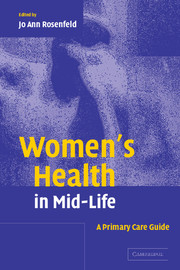
- Cited by 2
-
Cited byCrossref Citations
This Book has been cited by the following publications. This list is generated based on data provided by Crossref.
Cobia, Debra C. and Harper, Amney J. 2005. Perimenopause and Sexual Functioning: Implications for Therapists. The Family Journal, Vol. 13, Issue. 2, p. 226.
Fisher, Bernadette Dowding, Dawn Pickett, Kate E. and Fylan, Fiona 2007. Health promotion at NHS breast cancer screening clinics in the UK. Health Promotion International, Vol. 22, Issue. 2, p. 137.
- Publisher:
- Cambridge University Press
- Online publication date:
- August 2009
- Print publication year:
- 2004
- Online ISBN:
- 9780511545672




